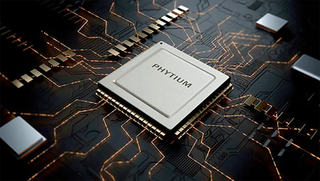Chinese chipmaker Phytium sells over 10 million homegrown CPUs — Feiteng processors are primarily used in national projects and key local industries
The local Chinese chipmaking industry is getting a massive boost from Beijing.

As Beijing blocks American silicon like AMD and Intel from government use, Chinese chipmaker Phytium reported selling over 10 million Feiteng series processors. Taiwanese media outlet IT Home (machine translated) said that most of these chips are used in key national projects and industries and can be found anywhere from cloud servers to terminals used by end users.
Despite being put on the U.S. entity list, meaning Phytium cannot legally import and use American-made components, it was still able to develop and build advanced chip solutions. For example, last year, the company revealed the 64-core Feiteng Tengyun S2500 server CPU and the Phytium FTC870, rivaling Arm’s Neoverse N2 chip. It also released the Feiteng Tengrui D3000 desktop processor for use in the office setting.
Phytium isn’t the only chip maker gaining an advantage with China’s move away from Western chips. Loongson is another chip maker getting wider acceptance, reportedly shipping 10,000 chips to Chinese schools. The company is also said to have put one of its processors aboard the Tiangong Space Station, a milestone for China’s push to use homegrown tech. Other chip makers like Huawei and Hygon are also expanding their market share, especially as Chinese telcos are shifting away from Western tech.
While many say these Chinese chips are still behind the latest American tech by about a decade, China is still making leaps and bounds in advancing its homegrown processors despite Washington's bans and sanctions against the country. This is likely why U.S. Commerce Secretary Gina Raimondo said holding back China’s chipmaking progress is a fool’s errand. Even the U.S. Senate found that enforcing the White House’s moves against the Chinese tech industry is largely inadequate owing to the Department of Commerce’s lack of funding.
Phytium and other homegrown tech used in Chinese industries will significantly affect the future of China’s silicon. As the Chinese government purchases these chips in the millions, the companies making these processors could reinvest their earnings in research and development to further improve their tech. The Chinese private sector might also follow suit, mainly if these local chip makers could produce chips with just the right amount of processing power at a much lower cost.
With hundreds of thousands, if not millions, of government employees using these computers, we might soon see individual Chinese consumers wanting to buy these processors. After all, this was how the U.S. consumer was introduced to PCs in the 1980s and 1990s, allowing companies like Compaq, Dell, and HP to move from the office into the homes of many Americans.
Stay On the Cutting Edge: Get the Tom's Hardware Newsletter
Get Tom's Hardware's best news and in-depth reviews, straight to your inbox.

Jowi Morales is a tech enthusiast with years of experience working in the industry. He’s been writing with several tech publications since 2021, where he’s been interested in tech hardware and consumer electronics.
-
Gururu Its nice to see a nation make achievements on their own, keeps competitive nations on their toes.Reply -
bit_user Reply
First, the FTC870 and N2 are cores, not chips. Second I'm quite skeptical of this claim.The article said:For example, last year, the company revealed the 64-core Feiteng Tengyun S2500 server CPU and the Phytium FTC870, rivaling Arm’s Neoverse N2 chip.
From the linked article, here's the performance data they quoted:
Pay close attention to the N1-based Altra. If we compensate for the clockspeed difference, it should get scores of 4.73 and 5.36 at 3 GHz. That would make the N2 24.0% and 27.8% faster, respectively. These numbers are significantly below how ARM said their N2 cores compare with N1:
Also, I wonder what vehicle they even had for measuring the N2 cores, like 14 months ago (when Phytium published its slide).
I'm also quite curious how they compare on energy efficiency and scalability. I think probably not well. -
erazog Well they are going to run into a semiconductor manufacturing wall eventually which will stall development.Reply
The companies that control the secrets to advanced nodes are closed to outsiders and these are co-operating with Washington. It will take them 15-20 years to close the gap of now and western fabs wont be sitting still and moving forward.
Most Popular




